One of the most fun things to do in games after finishing their campaign is to explore their mechanics and find unusual ways to take advantage of them.
Often, this means subverting the rules established by the game to create broken combinations, capable of trivializing the journey and making battles against stronger enemies much easier, like the recurring superbosses of the Final Fantasy series.
Final Fantasy has a long gaming history. In that time, its fans have found the most interesting ways to break down the metrics of the main games via skills, equipment and combinations that were overlooked during the development.
In this article, we present the most broken features of each main game in the franchise. This selection was made considering options that continue to be available in the most recent versions of their respective games, therefore, MMOs, which have recurring updates and skill or jobs nerfs, were left out of the list.
For the same reason, combinations removed from the most recently available versions of their games, such as Cat Nip Happy Trigger from Final Fantasy X-2, were not considered.
Final Fantasy - Excalibur + Temper + Haste
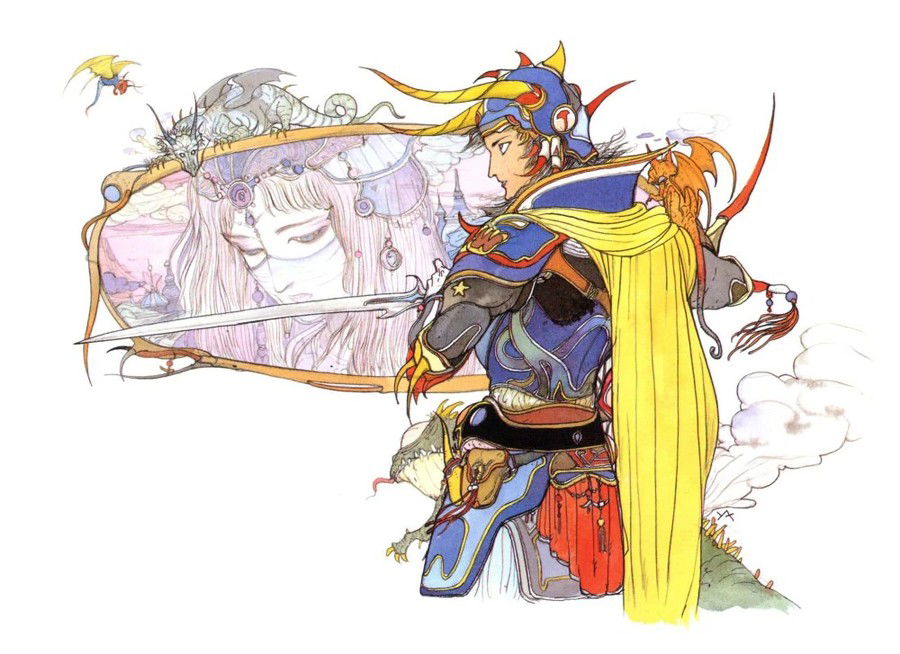
For a game whose original release suffered from bugs and was very challenging, the first game in the series is well-balanced when we think about broken mechanics - in its most recent version in Pixel Remaster, it is an excellent example of balance in the natural progression of the plot and its mechanics.
The sword Excalibur is the strongest weapon in the game for practical purposes in the original versions, as in addition to its high attack, it counts as all elements and has all bonuses against different types of monsters, causing its damage per turn surpasses even Masamune's, but with the disadvantage that only Knights can wield it.
It is possible to further amplify its damage by combining the Haste and Temper spells, available to Black Wizards and Ninjas - if combined with the high defense of Knights and the potential to exploit weaknesses with Excalibur, it is easy to transform him into a one-man army while the other jobs offers support.
Final Fantasy II - Blood Sword
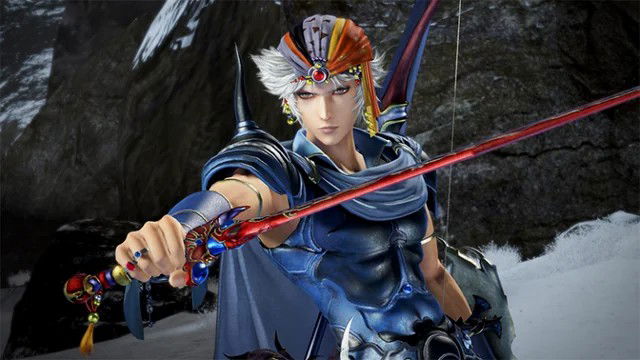
Final Fantasy II is a game known for its difficulty depending on how much a player understands its mechanics and is willing to explore them, but there is a specific weapon in the game that makes any boss a walk in the park: the Blood Sword.
Found in Paul's house after he revealed the secret passage, this sword is not the most appropriate weapon for fighting common enemies with low HP, but it has the highest damage potential against bosses in the game due to its damage calculation, which absorbs 1/16 of the hit target's maximum HP, regardless of how much it still has available.
Therefore, against powerful enemies and even in the final boss battle, the Blood Sword offers an absurd amount of damage that surpasses any other weapon in the game while also healing its user, making it one of the easiest methods of beating Final Fantasy II.
Final Fantasy III - Shuriken
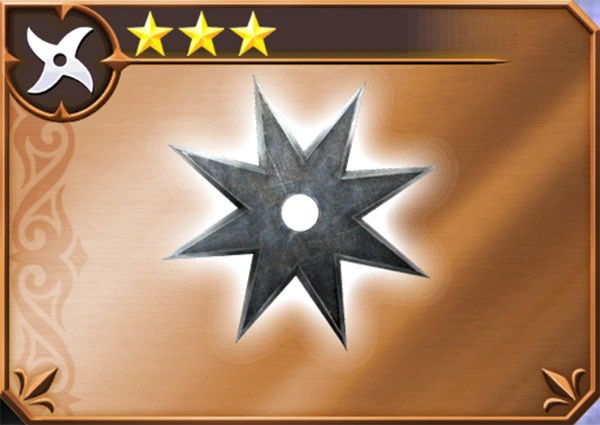
Final Fantasy III was the first game to have a wide variety of jobs and the possibility of switching between them to evolve your character. However, in the original release and in the Pixel Remaster version, the progression between them seems to culminate, in the end, in two that offer all the qualities of the others: Sage and Ninja.
Sage is the supreme spellcaster in FF3, with excellent attributes while being able to equip any spell of any level, while Ninjas are the supreme warriors and can equip any weapon or armor, as well as being the only one capable of using Shuriken, the true most powerful weapon in the game!
With 200 power, the Shuriken deals, on average, between 5,000 and 9,999 damage to an enemy, but is discarded after the attack, making it a single-function equipment. Players can buy them in a secret shop in the Eureka dungeon for the price of 65,500 Gil, and given their high attack power and how late we have access to Ninjas, you don't need many of them to get through the later stages of the game.
Final Fantasy IV - Throw
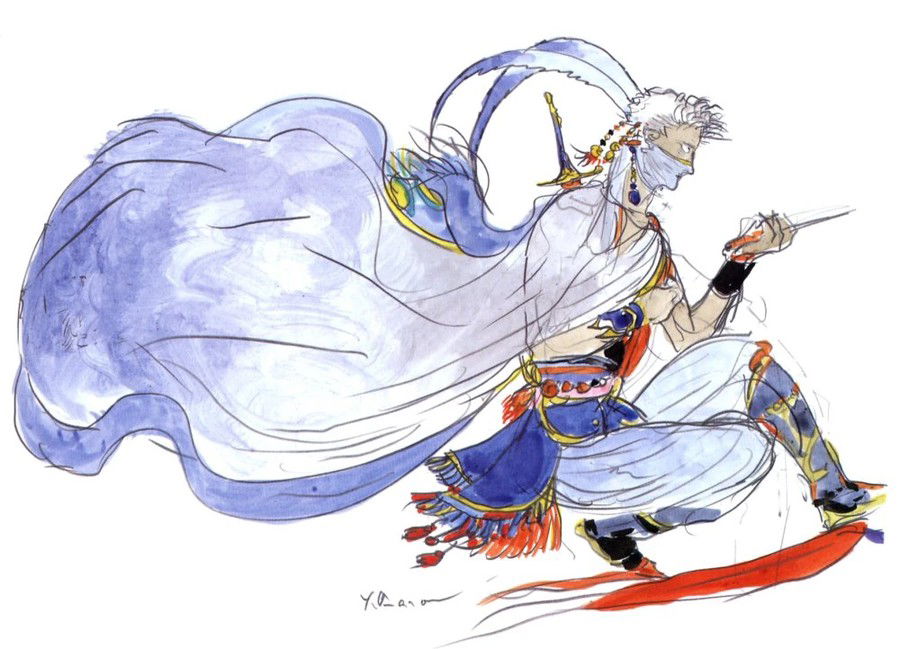
Final Fantasy IV's greatest contribution to the series was implementing a combat system innovation known as ATB, or Active Time Battle, which made battles more dynamic by making enemies and allies take actions as their action bar filled.
The game had another essential and invisible mechanic to the player's eyes, Charge Time, or CT, which defined how long it took between choosing the action in the menu and the character executing it in combat, and it was quite simple : the stronger the skill, the longer it took for it to occur in battle.
Edge's ability, Throw stands out for its mixture of high damage potential combined with a very short charge time, and the advantage that thrown weapons ignore the enemy's defense, making any spare equipment in the inventory a great resource during the battles.
If that wasn't enough, finishing a side quest in Final Fantasy IV rewards the player with a specific item, Knife, which can be thrown by Edge for a guaranteed 9,999 damage.
Final Fantasy V - Dual Wield + Spellblade + Rapid Fire
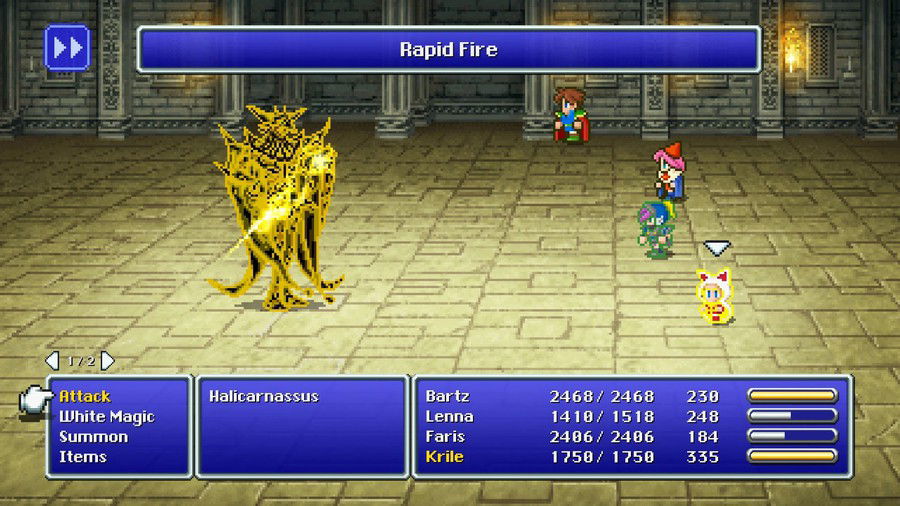
The combination between the Ninja's Dual Wield, the Mystic Knight's Spellblade and the Ranger's Rapid Fire is so classic and well-known that it became Bartz's special attack in the Dissidia series.
Due to FF5 mechanics, the characters' base job, Freelancer, is blessed with greater skill customization than the others - therefore, they become much more flexible in rewarding heroes' progress in other jobs, in addition to allowing specific builds more freely.
With this combination, a character can equip two weapons through Dual Wield and attack up to four times with Rapid Fire, but each instance of it will use both equipped weapons, totaling eight attacks in a single turn.
The Mystic Knight's Spellblade is part of the combination to add elemental properties to attacks, or amplify their overall damage by imbuing their weapons with higher-level magic, allowing the player to exploit their opponents' weaknesses.
Final Fantasy VI - Ultima Weapon + Genji Gloves + Master’s Scroll
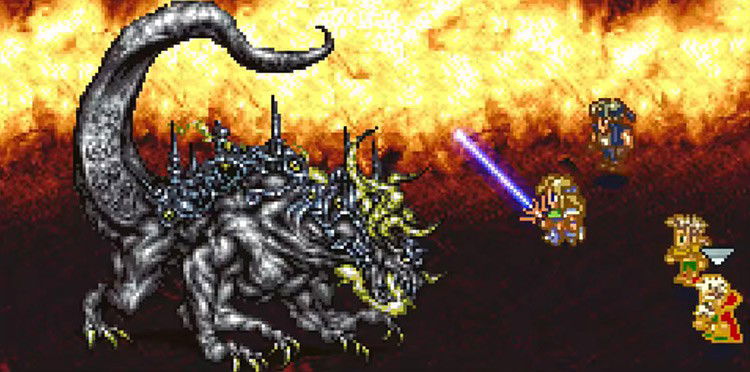
Final Fantasy VI abandoned the job system in favor of highly customizing its characters through accessories and Espers, while each of them also had their own combination of skills and equipment to make them unique.
These accessory combinations can bring some of the most broken patterns in the series, and the one that stands out most is the combination of Genji Gloves, which allows equipping a weapon in each hand and Master's Scroll which makes the equipped character attack four times in a single turn.
The essence of this combo is the same as seen in Rapid Fire and Dual Wield from Final Fantasy V. However, a third element can be added to it to maximize its damage: the Ultima Weapon.
This sword increases its damage as its user's HP grows and ignores the enemy's defense - with a high enough level and HP, each attack of it can do 9,999 damage, a total of 39,996 with Master's Scroll, not counting the damage caused by the secondary weapon.
Final Fantasy VII - W-Item Glitch
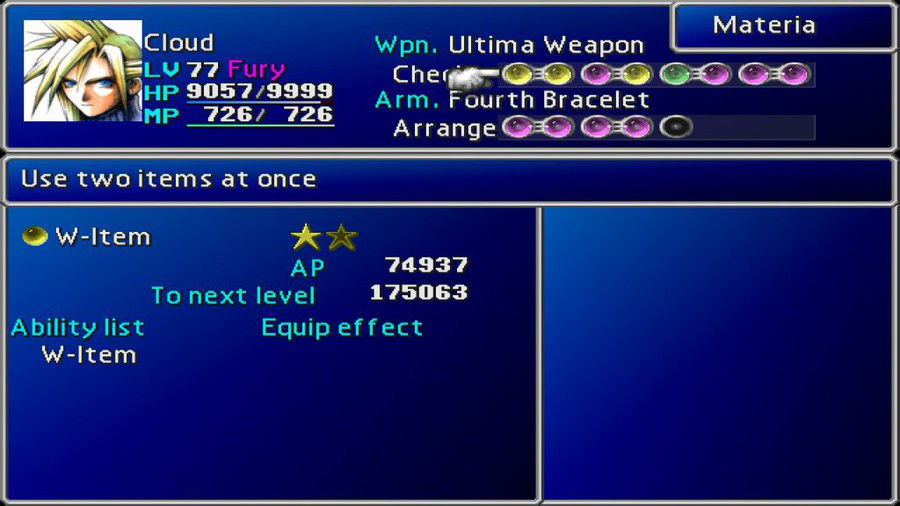
Final Fantasy VII is well known for the various possible ways to break its mechanics, whether with the potential for “infinite life” with Final Attack and Phoenix, or with the famous “overflow” that Barret and Vincent can cause with their best weapons, but none of them sound as broken and easy to obtain as the possibility of having infinite items with W-Item.
Due to a bug in the count during selection, the W-Item, which allows you to choose two items to be used in a single turn, can increase any item selected by it the first time by one unit, and repeat this process as many times as the player wants.
Simply select the first item and its target and, when choosing the second item, cancel its selection when choosing the target - when you return to the menu, you will have one more unit of the first item.
This process can be repeated indefinitely during a battle, allowing the player to create a stock of up to 99 units of any item, including Megalixirs, Hero Drinks and other essentials to defeat the most difficult bosses in the game.
This glitch is so broken that it's surprising that it still exists in the most recent versions of Final Fantasy VII for Steam and current-gen consoles, when Square could just have released an update to permanently remove it from the game.
Final Fantasy VIII - Armageddon Fist
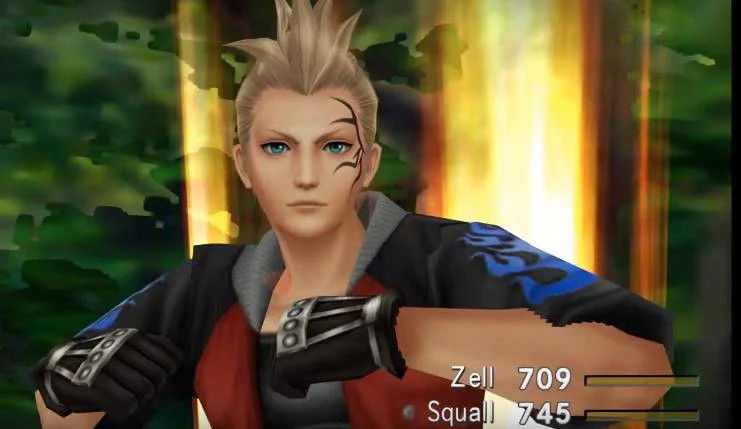
One of the main innovations of Final Fantasy VIII revolved around the execution of Limit Breaks, where many characters had more interactive commands during their execution. One of these involves the fighter Zell Dincht and his combo mechanics with Duel.
In it, Zell has a timer to execute a sequence of attacks with control commands, where the right combination would make him use a new attack, he can perform as many actions as the player wants while there is enough time and as long as the character does not perform a command which leads to a finishing blow, like “Different Beat” or “My Final Heaven”.
The possibility of breaking Duel is in the character's first three commands: Booya, Heel Drop and Punch Rush, where the three require just two buttons next to each other to be executed and none of them is a finisher - therefore, the player can repeat these actions several times in a turn until the time runs out, with an average of half a second per command or even less when they memorize the rotation between them.
If we equip spells to maximize Zell's strength and speed and use Aura on him to enable his Limit even at full HP, he becomes a boss-defeating machine while greatly limiting the number of actions of other allies and enemies, creating a sequence of almost infinite turns, in a combination known to fans as Armageddon Fist
Final Fantasy IX - Counting Skills
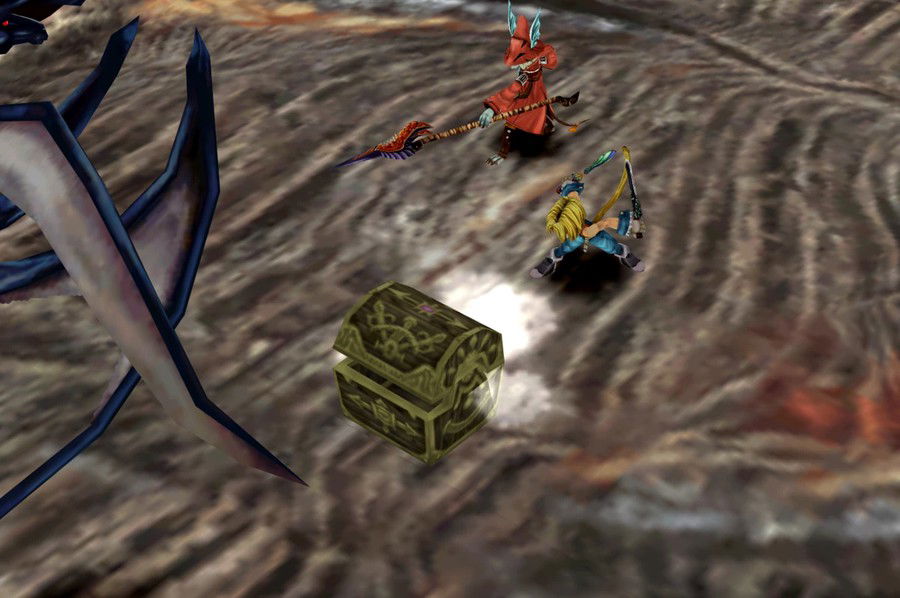
Following the tradition of the first game, Final Fantasy IX is much more balanced compared to its predecessors: there is no absurd sequencing of skills and no way to attack multiple times in a turn.
Therefore, the best proposal to explore its mechanics involves three characters capable of consistently dealing 9,999 damage each turn: Zidane, Freya and Quina, with the skills Thievery, Dragon’s Crest and Frog Drop.
Its power increases as the player takes certain actions during the game. Zidane's Thievery gains power equivalent to the number of times the character stole from an enemy. Freya's Dragon's Crest amplifies its damage based on the number of dragons the player has already defeated, and Quina's Frog Drop counts the number of frogs captured in the Qu's Marsh minigames and the character's level.
They all require a lot of time and patience from the player to be successful in dealing maximum damage: Dragon's Crest requires killing 100 dragons to deal maximum damage, while Thievery needs 625 steals and Frog Drop depends on a minimum of 101 frogs if you are at level 99.
The effort to acquire these numbers also does not seem necessary for any challenge in FFIX, as a round of 9,999 damage with three characters means dealing with the game's final boss and its superboss in just two or three rounds.
Final Fantasy X - World Champion + Attack Reels
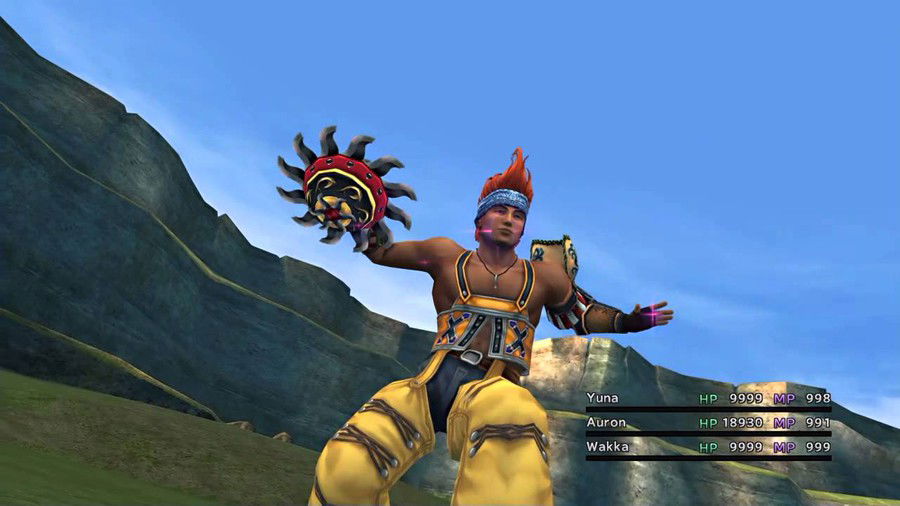
How Wakka manages to hold a weapon full of blades under his arm during fights is one of the main mysteries of Final Fantasy X, but it is a centerpiece against several of the game's secret and powerful bosses.
Acquired after countless hours of Blitzball matches, the World Champion guarantees Break Damage Limit for its damage to exceed four digits, Triple Overdrive, which triples the amount of Overdrive recharge and, like other Celestial Weapons from FFX, it ignores enemies' defense - making it lethal alongside Wakka's main special ability: Attack Reels.
Similar to Tifa's Limit Break in Final Fantasy VII, Attack Reels uses slots to set its multiplier, where the higher the numbers, the more attacks Wakka makes with the skill. If done properly, he can attack up to twelve times.
With enough grinding, the best weapon available to him, and enough training to master Attack Reels, Wakka can surpass the million damage mark with a single attack!
Final Fantasy XII - Invisible Equipment
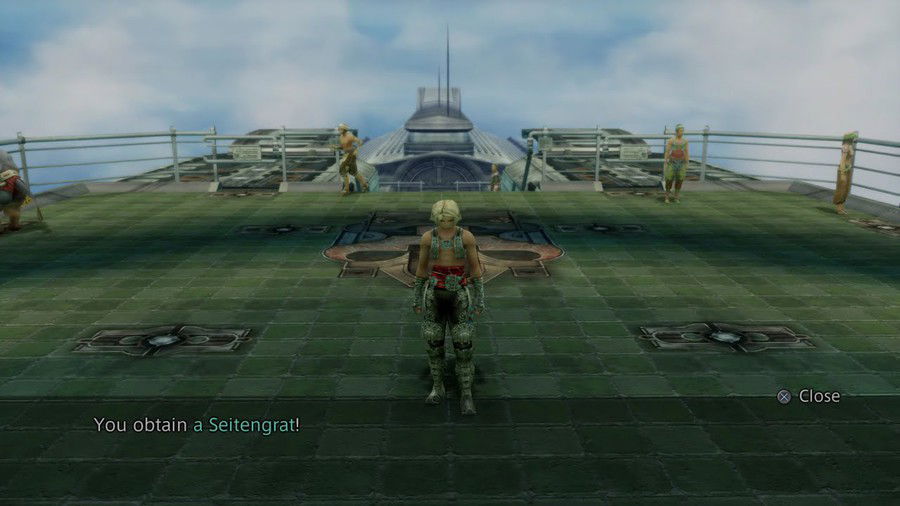
In the international versions and in The Zodiac Age, Final Fantasy XII has three pieces of equipment whose attributes break any symmetry present in the title: the bow Seitengrat, the sword Great Trango and the shield Gendarme, known as “Invisible Equipment” by literal reasons - none of them appear in the hands of the characters who equip them, nor do they make sounds when attacking or blocking.
The three are considered the best items in the game, as their attributes differ greatly from the other weapons and shields available in FFXII, with much higher defense, evasion and attack numbers and much lower charge times - they, alone, trivialize the combat any enemy to the point of making your characters almost invincible.
But acquiring them is an even more absurd task: the three pieces of equipment are hidden in invisible treasures in different regions of FFXII, and with a drop percentage that borders on the absurd, making them almost impossible to acquire without days or weeks of persistence, or through manipulation of the game's RNG system.
The Great Trango is also a rare item to steal against the Zodiark super boss, with a 3% sucess rate - much higher than the 0.02% from its chest. Given the enemy's high difficulty, stealing the sword while still surviving the combat is a great challenge, but also very rewarding, and it is even symbolic to obtain it through the most powerful Esper in the game.
Final Fantasy XIII - Highwind + Genji Gloves
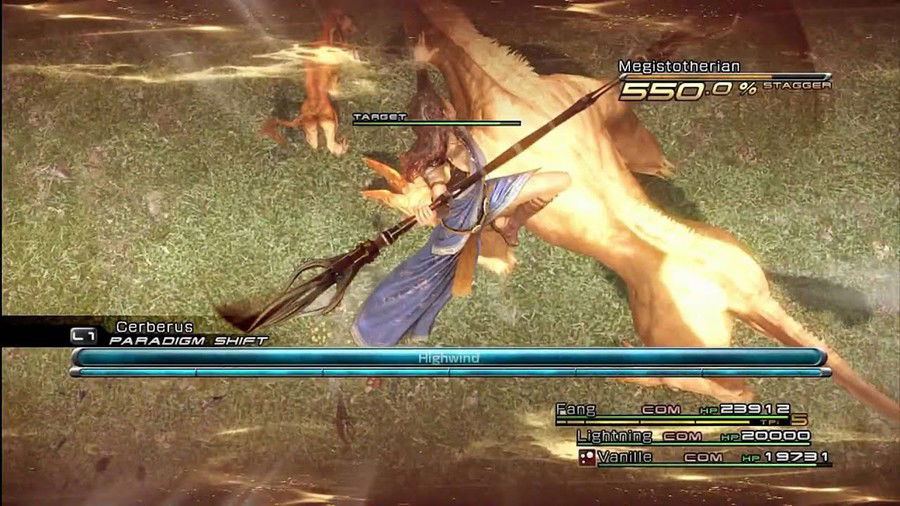
Final Fantasy XIII brought new limits to total damage, and therefore, it also established a new level of maximum damage caused by a single skill in a game in the series: with the right combination, Fang can cause almost two million damage with Highwind.
Highwind requires a full ATB to use, but ignores the enemy's defenses and any protection they have. Additionally, its damage is amplified against staggered opponents. With the right combination of attacks to amplify vulnerability percentage and debuffs, Fang can deal maximum damage in both attacks with Highwind.
The Genji Gloves are mandatory to reach these numbers, as it allows you to break the damage limit, creating an essential combination to face the most dangerous monsters in Gran Pulse, such as Long Gui.
Final Fantasy XV - Ragnarok and Ring of the Lucii
Final Fantasy XV has several unbalanced elements, but two pieces of equipment have stood out for a few months after the game's launch due to their high power, to the point of being banned during the Timed Quests.
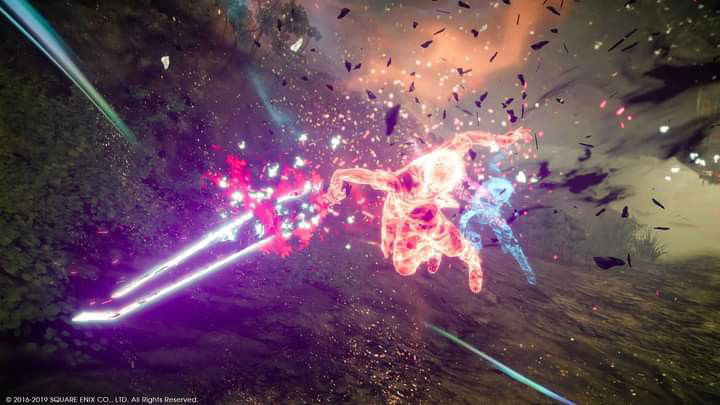
Ragnarok was added to the Season Pass when Final Fantasy XV was receiving periodic updates. However, the sword amplifies Noctis' Warp Strikes to the point it becomes completely unbalanced with the rest of the game while trivializing the gameplay to simply spamming warping and healing with Ethers.
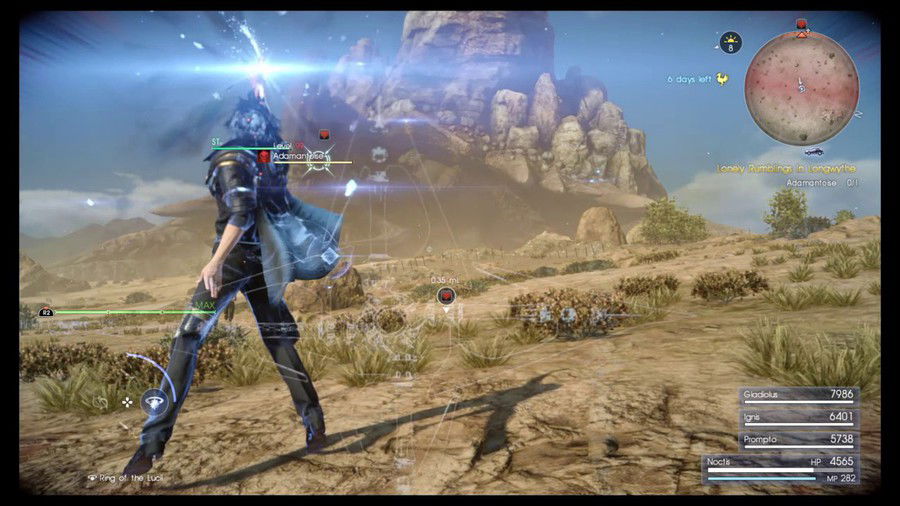
In the same way, Ring of the Lucii was heavily criticized at the time of FFXV's release for being too weak and not having the same impact on gameplay that it has on the narrative. An update brought improvements to the Ring, making it as unbalanced as Ragnarok to the point it could even one-shot Adamantoise, the colossal boss seen in the trailers.
Final Fantasy XVI - Cold Snap + Rift Slip
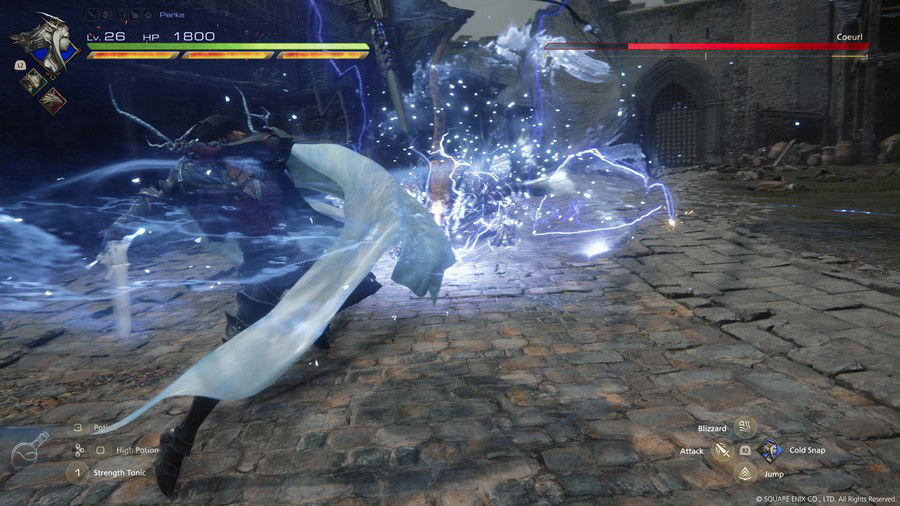
Since it is an action-focused game based on cooldown timers, Final Fantasy XVI allows for the most lasting combos through the combination of skills between Shiva's Cold Snap and Odin's Rift Slip.
Cold Snap, if used at the right time, freezes the enemy for a few seconds while Rift Slip freezes time, extending this period by a few seconds. The secret is how Cold Snap also freezes the enemy's stagger bar, extending the period in which we can maximize damage against them with our other abilities.
Combined with powerful attacks that also hold the stagger bar during execution, such as Dancing Steel, Zantetsuken, Gigaflare, and Diamond Dust, this combination allows extending staggers for minutes, as exemplified by the video below:
Final Fantasy Tactics - Tailwind + Accumulate/Scream
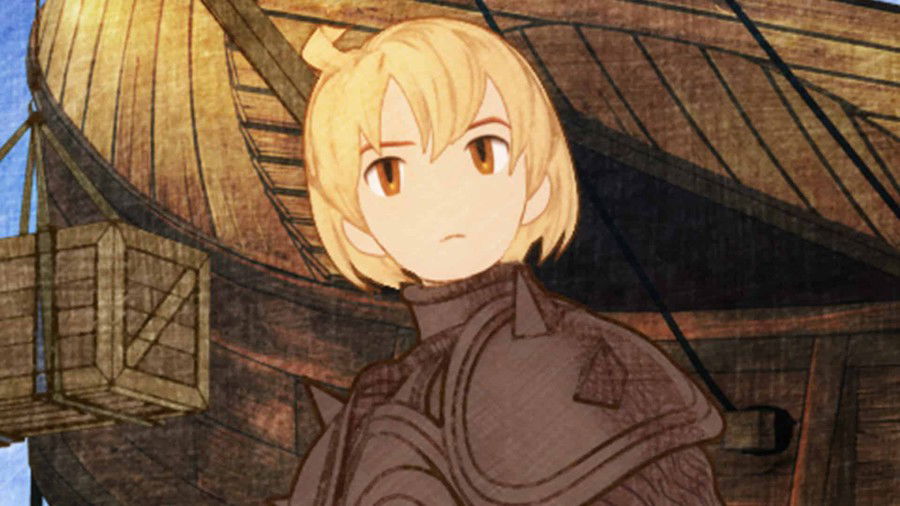
Ramza Beoulve seems to have one of the most basic jobs in the game, being nothing more than a Squire with some extra skills and a wider range of equipment - but secretly, the hero has some of the most broken combinations in the game.
Ramza begins the first chapter with the Tailwind ability available, which increases the target's speed by one point. In a short time and with good movement, it is easy to make him have two turns per round while other enemies only have one.
From this point on, there are numerous options for battle, but the most common includes using Accumulate for several turns in a row until the point where Ramza can defeat any enemy with a single attack.
Ramza also gains ten experience points for each time he uses these skills, so it's easy to get him overleveled early, as well as accumulating enough job points to transition between them and gain the skills needed to make him invincible, even capable of fighting “solo” during the game as soon as the player has the Monk job available to make the hero more self-sustainable with skills like Chakra and Aurablast.
Final Fantasy VII Remake - Götterdämmerung
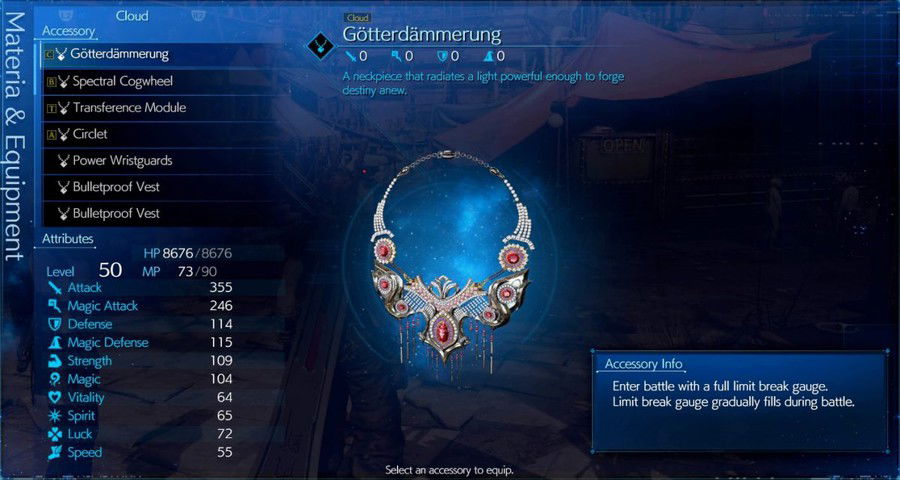
The Götterdämmerung is an accessory found in Final Fantasy VII Remake and one of the most broken pieces in the franchise's modern history. With it equipped, the character starts battles with their Limit bar full, and it gradually recharges during the fight.
The accessory is only found in the game's hard mode, being the reward for defeating the two most powerful bosses of the Combat Simulator in Chapter 17 and two more can be obtained once defeating Weiss after Episode Intermission, therefore having a symbolic reward function for overcoming all the challenges that FFVII Remake offers.
Final Fantasy VII Rebirth - ATB Spam / Limit Break Spam
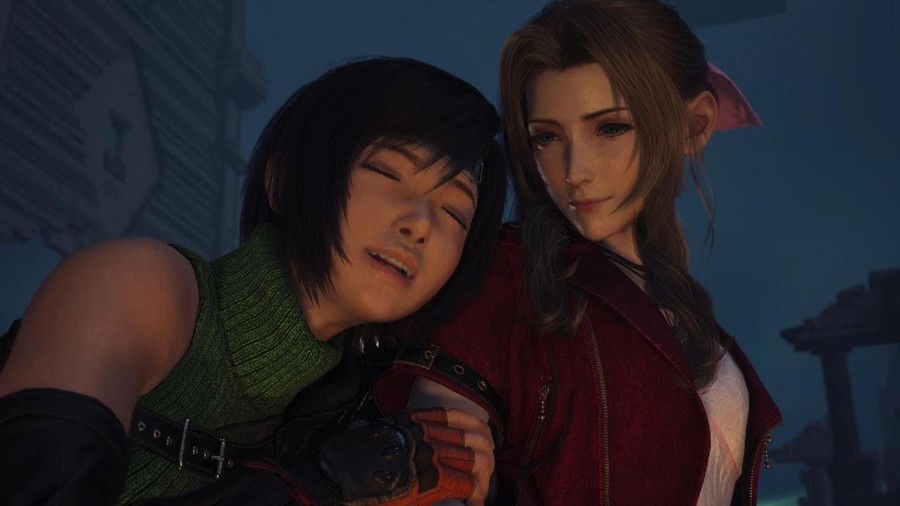
Final Fantasy VII Rebirth has quite a number of combinations between skills and Materias that can break the game's metrics and trivialize most battles. Among them, two notable options are the means of spamming abilities and Limit Breaks through synergy between characters.
The ATB Spam involves using the ATB Assist Materia on Yuffie with her Brumal Form ability while having her as the controllable character, in addition to using Aerith's ATB Ward on her.
Brumal Form requires a very low ATB cost to be used frequently while ATB Assist causes your allies to gain ATB as the controllable character uses abilities - once Yuffie has Haste, the cost for Brumal Form is greatly reduced, and thus, we can take advantage of the other characters' skills and perform more Synergy Abilities.
The Limit Spam involves Aerith's level 3 Limit, Rising Fury, which fills the Limit bar of the other characters. We should equip her with Limit Siphon and Enchanced Expeditionary Medal along with another character who has the ability to fill their Limit bar quickly - either with Götterdämmerung or other means, such as using Yuffie's ATB Spam along the Transfer Module accessory.
Aerith must then cast Limit Siphon to fill her bar completely and then use Raging Fury to fill the other characters' bars, one character can use their Limit Break while Aerith can Limit Siphon the other, and then use Raging Fury again, repeating the looping.
None of these combinations make the team completely invincible; however, they create significant advantages for the party and even trivialize gameplay against most bosses, enemies and combat simulators.
Conclusion
That's all for today!
If you have any suggestions or believe that a combination or another game deserves to be mentioned on the list, feel free to leave a comment.
And if you would like to know more about Final Fantasy and its universe, check out my list about the best villains in the franchise!
Thanks for reading!







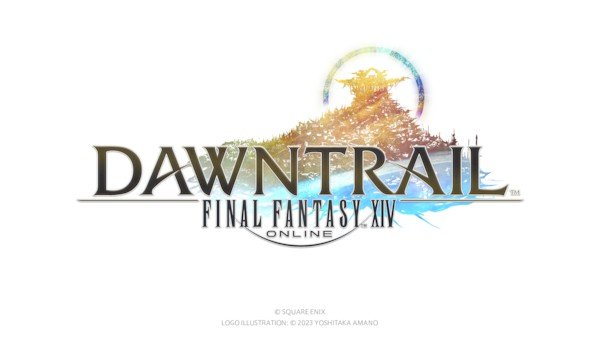
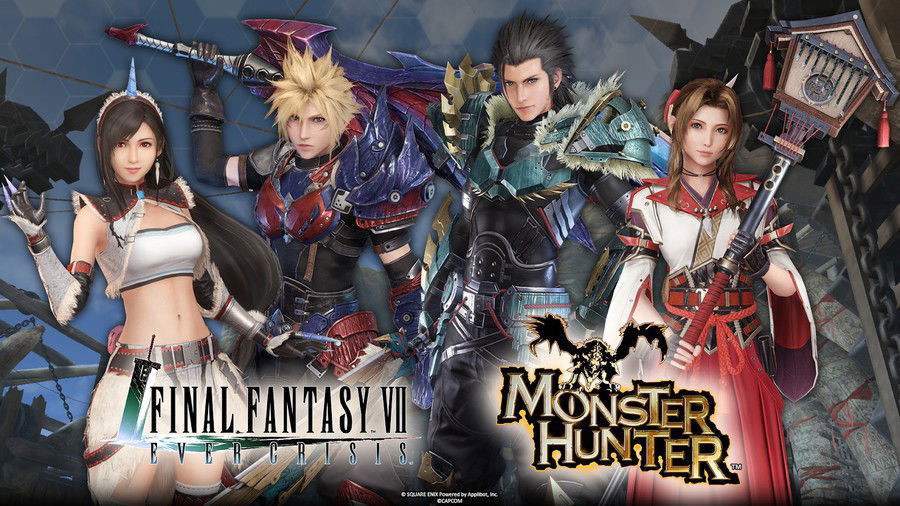



— Kommentare 0
, Reaktionen 1
Sei der erste der kommentiert